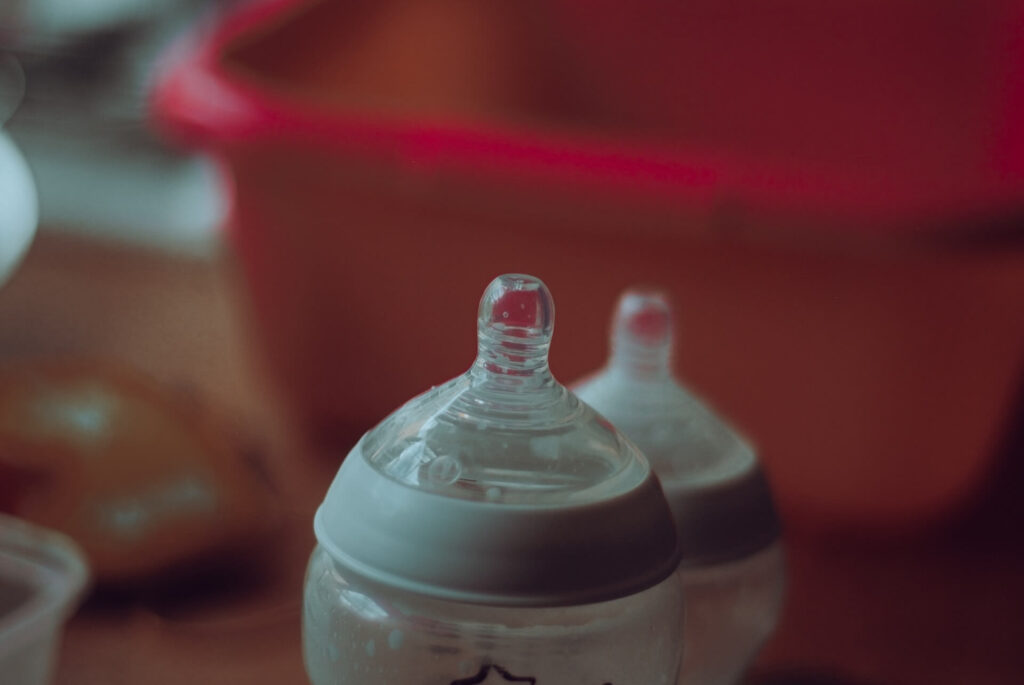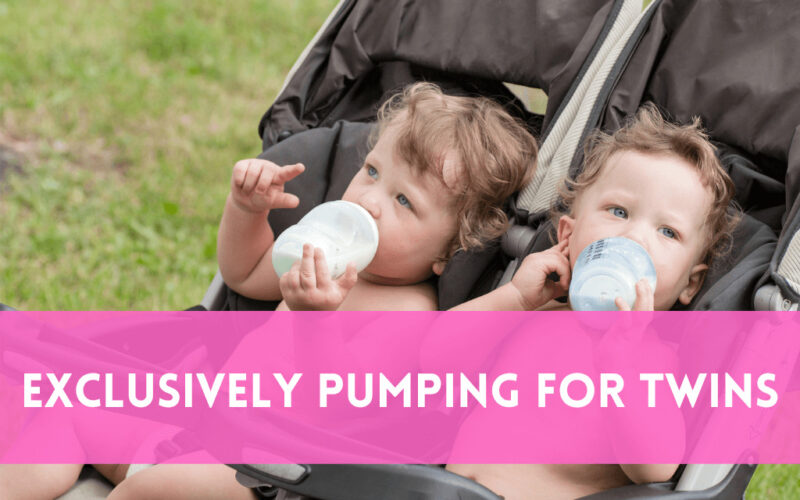Exclusive pumping refers to the practice of feeding a baby only with breast milk that has been expressed with a breast pump, without any direct breastfeeding. This means the mother exclusively provides her baby with breast milk through pumping, instead of directly breastfeeding.

There are various reasons why a mother might choose to exclusively pump, such as if the baby is not able to latch properly or if the mother has medical conditions that make breastfeeding difficult or painful. Additionally, some mothers may choose to exclusively pump in order to share the feeding responsibilities with a partner or caregiver or to have more flexibility in their schedules.
Exclusive pumping requires a significant amount of time and effort, as the mother must regularly pump milk and store it properly to ensure that it remains safe and nutritious for the baby. However, it can also be a rewarding and effective way to provide a baby with the benefits of breast milk, even if direct breastfeeding is not possible.
Exclusively pumping for twins can be a time-consuming and daunting task, but it is necessary for maintaining a sufficient milk supply and ensuring both babies are getting enough nutrients. It is recommended that twin moms begin pumping as soon as possible after delivery, even if their babies are in the NICU or unable to nurse right away.
Who is exclusively pumping breast milk suitable for?

Exclusively pumping is a good option if the mother or the baby has a medical condition that makes breastfeeding difficult or impossible. For example, if the mother has inverted nipples, her baby may have difficulty latching on. This makes it difficult for the baby to get enough milk if breastfed. In such a case, exclusively pumping ensures that the baby receives the proper amount of breast milk they need.
Exclusively pumping may also be a good option for mothers with busy work schedules that make it difficult to breastfeed their babies on demand. Pumping breast milk and feeding it to the baby in a bottle can be a good solution in this situation.
Some mothers may prefer exclusive pumping over breastfeeding for personal reasons. For example, they may feel uncomfortable with breastfeeding in public or prefer the convenience of pumping.
Benefits of Exclusively Pumping

Exclusively pumping, when done correctly and consistently, can offer several benefits to both the mother and baby. Some of these benefits include:
- Breast milk is the perfect food for babies, as it contains all the necessary nutrients and antibodies essential for their growth and development. You do not have to use formula milk or other alternatives when practicing this method.
- Exclusive pumping can help increase a mother’s milk supply, especially if she pumps regularly and on a consistent schedule.
- Exclusive pumping allows mothers to be more flexible with their feeding schedules, as they can pump milk in advance and store it for later use. This can be particularly helpful for mothers who work outside the home or have other commitments.
- Exclusive pumping allows partners and caregivers to participate in feeding the baby, which can help foster bonding and reduce the mother’s workload.
- Regular pumping can help improve lactation and milk flow, which can benefit breastfeeding in the future if the mother decides to transition from exclusive pumping to direct breastfeeding.
- Exclusive pumping allows mothers to track their babies’ milk intake. It can allow mothers to measure the amount of milk their baby is consuming and can provide peace of mind that their baby is getting enough nutrition.
What are some challenges mothers face while exclusively pumping breast milk?
Exclusive pumping can be physically and emotionally demanding, and it is important for mothers to take care of themselves by eating a healthy diet, staying hydrated, getting enough rest, and seeking support from healthcare providers or lactation consultants when needed.
Some of the common challenges of exclusively pumping breast milk are:
- Exclusive pumping requires a significant time commitment. A mother may need to pump every two to three hours to maintain her milk supply, which can be difficult to manage along with other responsibilities.
- Using a breast pump can be uncomfortable for some mothers, especially if they have sensitive nipples or engorged breasts.
- Some mothers may struggle to maintain their milk supply while exclusive pumping. This can be due to issues such as not pumping often enough, not using the correct technique, or high levels of stress.
- Exclusive pumping can make it more difficult for a mother to establish a breastfeeding relationship with her baby. Breastfeeding provides not only nutrition but also bonding opportunities and physical contact that are important for a baby’s development. This means that babies may miss out on the emotional benefits of breastfeeding, such as skin-to-skin contact and the release of feel-good hormones.
- Expressed breast milk needs to be stored and handled carefully to ensure that it remains safe for the baby to consume. This can be challenging, especially if the mother needs to transport the milk to and from work or other locations.
- Breast pumps and related supplies can be expensive, and some insurance plans may not cover them. This can be a financial burden for some mothers.
How do you store milk that has been pumped exclusively?

Storing breast milk that has been pumped exclusively is important to ensure that it remains safe for the baby to consume.
The first step is to use sterilized containers that are specifically designed for storing breast milk. Plastic bags, glass bottles, or hard plastic containers with tight-fitting lids can all be used. You will also want to use labels to monitor the date of the milk. This allows you to ensure that the oldest milk or the milk that you exclusively pumped in the beginning is used first.
It is best to store breast milk in small amounts, typically no more than 2 to 4 ounces per container. This can help prevent waste and ensure that the milk is thawed and reheated properly.
You should store the milk in the back of the fridge or freezer where the temperature is coldest, and where it is less likely to be exposed to temperature fluctuations. Freshly expressed milk can be stored in the refrigerator for up to 4 days at a temperature between 32°F and 39°F.
If the milk is not used up within 4 days, you may freeze it. Freshly expressed milk can be stored in the freezer for up to 6 months at a temperature of 0°F.
How do you thaw frozen breast milk?
Thawing frozen breast milk correctly is important to preserve its nutritional and immunological properties. You will want to thaw the breast milk slowly to prevent the loss of nutrients and to ensure that it heats evenly. The best way to thaw breast milk is to transfer it from the freezer to the refrigerator and allow it to thaw overnight.
If you need to thaw the breast milk more quickly, you can place the container of frozen breast milk in a bowl of warm water. Avoid using hot water, as this can damage the nutrients in the milk.
Once the breast milk has been thawed, gently swirl the container to mix the fat layer back into the milk. It is important that you do not shake the container vigorously, as this can damage the proteins in the milk.
Once the breast milk has been thawed, it should be used within 24 hours. You should never refreeze thawed breast milk as it can further degrade the quality of the milk and result in additional nutrient loss. Moreover, refreezing thawed breast milk can create an environment for bacterial growth, which can potentially cause illness in the baby.
Common Mistakes of Exclusively Pumping
Some common mistakes of exclusively pumping include:
- Inadequate pumping: In order to maintain the milk supply, it is important to pump regularly and frequently. If you skip out on pumping sessions or if you are not pumping for long enough, you may notice a decrease in your milk supply.
- Incorrect pump settings: Using the wrong suction or speed settings on a breast pump can cause discomfort or even pain, and can also affect milk output. It is important to experiment with different settings to find what works best for you.
- Not using the right size breast shield: Using a breast shield that is too small or too large can impact milk output and cause discomfort. Make sure to find the right size breast shield for your nipple size and breast shape.
- Improper storage: Storing breast milk incorrectly can lead to spoilage or contamination. It is important to follow proper guidelines for storing breast milk, such as using sterilized bottles and storing milk in the refrigerator or freezer.
- Not seeking support: Exclusively pumping can be a challenging process, and it is recommended to seek support from healthcare providers, lactation consultants, and other mothers who have gone through the same experience. Not seeking support can lead to feelings of isolation and can impact the milk supply.
- Not taking care of yourself: Exclusive pumping can be physically and emotionally demanding, and it is important to take care of yourself by eating a healthy diet, staying hydrated, getting enough rest, and taking breaks when needed.
By being aware of these common mistakes, mothers who exclusively pump can improve their chances of success and make the process more enjoyable and less stressful.
How often should you exclusively pump?
The frequency of pumping breast milk will depend on various factors, such as the age of the baby, how much milk the mother is producing, and the feeding schedule of the baby.
In general, lactation experts recommend that mothers who are exclusively pumping should aim to pump at least 8 to 10 times per day, or every 2 to 3 hours, in order to maintain milk production and provide enough milk for the baby. This is especially important in the early weeks after birth when milk production is still being established and when the baby typically feeds more frequently.
As the baby grows, and their feeding schedule becomes more predictable, the mother may be able to pump less frequently. However, it is important to pay attention to the baby’s feeding cues and adjust the pumping schedule as needed to maintain milk production. It is also important to remember that exclusive pumping can be time-consuming and may require some trial and error to find a pumping schedule that works best for both the mother and the baby.
How much should you produce while exclusively pumping?
A baby typically needs around 19 to 30 ounces of breast milk per day, depending on their age and weight. If you have twins, you should pump double that amount per day. Mothers usually pump for around 15-20 minutes or until milk flow slows down. If the milk flow slows down before 15 minutes, you might want to continue pumping for a few more minutes.
Mothers who are exclusively pumping should aim to produce enough milk to meet their baby’s needs. The average amount of milk that a mother produces while exclusively pumping can range from 25 to 35 ounces per day, but some mothers may produce more or less than this amount.
It is important to remember that every mother and baby is different and that milk production can vary throughout the day and from day to day. Pumping frequency and effective pumping techniques can help to stimulate milk production and increase milk supply.
Is exclusively pumping a good idea for twins?

Mothers of twins who are exclusively pumping will need to pump at least 8 to 10 times per day, or every 2 to 3 hours, to maintain milk supply and provide enough milk for both babies. This can be challenging to manage, especially in the early weeks after birth when milk production is still establishing and when the babies typically feed more frequently.
Additionally, exclusively pumping for twins may require a larger supply of breast milk storage containers and may take up more space in the refrigerator or freezer. It may also require more time to clean and sanitize pump parts.
However, exclusively pumping for twins is a rewarding experience for parents. Many mothers find it easier to bottle feed twins at the same time rather than breastfeeding them simultaneously.
By investing in a high-quality, hospital-grade double breast pump, you will be able to save time and energy in the long run. You may want to massage your breasts before and during pumping to stimulate milk flow and increase your milk output while exclusively pumping. It is important for twin moms to establish a pumping routine that works best for them, whether it involves pumping both breasts at the same time or alternating between each breast.
Conclusion

Exclusively pumping for twins requires a lot of dedication and effort, but it is worth it to ensure that both babies receive the best possible nutrition. With proper planning and support, exclusively pumping can be a successful way to provide breast milk to twins.








